
Module 1:
What are they?
The tobacco industry has been evolving the idea of an electronic cigarette for decades.
Click through the timeline to see some of the major points in e-cigarette history and the prevention efforts across the country.
Then, take a look at how vape products have evolved, and the dangerous chemicals found inside.
1930
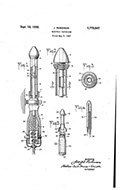
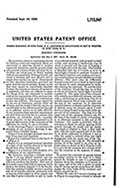
The first documented reference to an electronic cigarette emerges.
1965
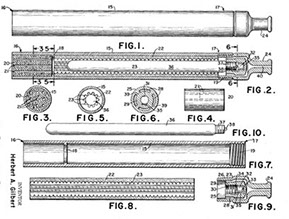
The first prototype of an e-cigarette is created by Herbert Gilbert.
1979
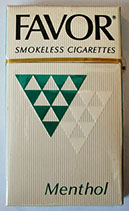
The first produced smoke-free device, known as Favor, is sold in America by Advanced Tobacco Products INC. The term “vape” is also introduced to the tobacco language.
1987
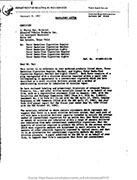
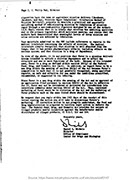
The FDA bans the product Favor and classifies it as a drug because of its intended uses to satisfy nicotine dependence and affect the structure or functions of the human body.
1990s
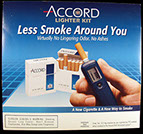
Philip Morris and RJ Reynolds patent and produce “heat-not-burn” devices that combines electronic cigarettes and combustible cigarettes. While these products didn’t
gain a lot of popularity, RJ Reynolds device has been redesigned over the years and is known as IQOS today.
2003
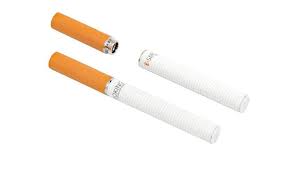
Chinese pharmacist Hon Lik produces the first generation of e-cigarettes known as the
“Cig-A-Like.”2004

While attending Stanford University, James Monsees and Adam Bowen create Ploom, which is now known as JUUL.
2006
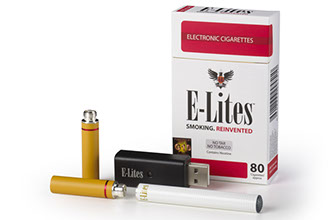
The first generation of e-cigarettes are introduced to the U.S. market.
2008
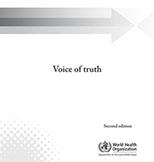
The World Health Organization (WHO) publishes a press release stating e-cigarettes are not safe devices and demands tobacco companies to immediately remove false statements of being safe.
2015
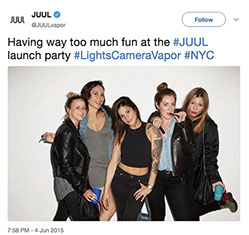
Pax Labs launches JUUL in New York City.
2016
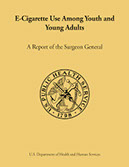
The U.S. Department of Transportation bans e-cigarette use on planes.
The U.S. Surgeon General publishes the first “E-Cigarette Use Among Youth and Young Adults” report identifying
e-cigarette use among youth as a major public health issue.2018
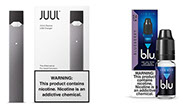
The FDA issues warning letters to 17 e-liquid companies for selling e-liquids that resemble youth-friendly food products.
The FDA seizes more than 1,000 pages of documents from JUUL Labs depicting marketing practices to target youth.
The FDA deems a nicotine warning label must appear on all e-cigarettes and vapes.
2019

Youth vaping rates skyrocket to 6.2 million U.S. youth vaping.
JUUL Co-founder and Chief Product Officer James Monsees testifies before Congress about the marketing and advertising tactics used to target youth.Walgreens, Kroger and H-E-B announce they will no longer sell vaping products.
2020

Legislation is passed across the country banning e-cigarettes and flavors. CEOs of 5 major vaping companies testify before Congress.
2022
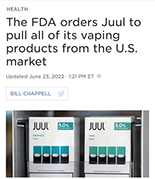
June 23rd - The FDA issued marketing denial orders to JUUL Labs Inc. to remove all of their products currently in the U.S. market. As a result, the company must stop selling and distributing and products already in the U.S. market must be removed.
June 24th - The U.S. Court of Appeals entered a temporary stay of the marketing denial orders for JUUL Labs Inc.
July 5th - The FDA announced they would make additional reviews of the JUUL product but moving forward all e-cigarette products, including JUUL, are required by law to have FDA authorization to be legally marketed.
2023
New devices contain more nicotine. Disposable e-cigarettes are 3x stronger, hold 5x more e-juice, and are 70% cheaper.
2024
“Smart” Vapes are entering the marketplace. These devices include “smart” technology like Bluetooth and voice recognition. Some devices also include games like Pac-Man.
While the electronic cigarette has evolved over the years into a variety of discrete devices, the most commonly used e-cigarette among youth today is known as the vape pod device. Vape pod devices have been designed to look like USBs, highlighters, pens and other school supplies as well as everyday items and food products.
Can you spot the vapes?

There is very little difference between vapes, vape pens, JUULs, Puff Bars and other e-cigarettes. They are all battery powered devices that deliver toxic liquid or e-juice that turns into an aerosol.
Here’s a breakdown on how vapes work:
Lithium Battery
E-Cigarettes use lithium-ion batteries to power the device. These batteries can heat up to 400 degrees, which can cause explosions resulting in life-threatening injuries.
See for yourself here.
Atomizer & Heating Coil
All e-cigarettes contain an atomizer with a heating coil. When the user inhales through the mouthpiece, the battery turns on the atomizer and heating coil to work together to turn the
e-liquid into vapor.
Cartridge
E-Cigarette cartridges or vape pods contain the e-liquid that is turned into aerosol. There are at least 64 different harmful and toxic chemicals found in e-juice.
See for yourself here.
Nicotine Salts
Diacetyl
Nicotine Salts
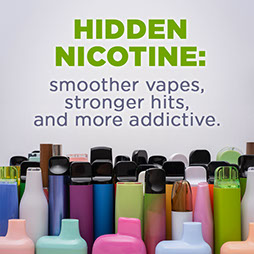
Most e-cigarettes contain nicotine, the highly addictive substance found in tobacco products. In fact, the Centers of Disease Control and Prevention (CDC) reports that 99% of vapes sold contain nicotine. While some vape labels do not disclose this, others falsely claim to contain 0% nicotine even though they still have it.
The introduction of nicotine salts or “nic salts” in e-cigarettes began with the popular JUUL product. However, after its success, other companies quickly followed. Today, well-known brands like Elf Bar, Breeze, Mr. Fog, Vuse, and JUUL all use nicotine salts in their products. A study from 2023 found that about 28% of e-cigarettes contain nicotine salts.
The issue with nicotine salts is that they mask high nicotine levels by combining the nicotine with different acids, like benzoic acid, which reduces the harshness of the hit. This allows users to inhale larger amounts of nicotine without discomfort, making it more tolerable and addictive- especially for those experimenting with vaping. Those who vape may also experience stronger and faster side effects because of the higher nicotine intake. E-liquids with nic salts typically have concentrations around 3mg-50mg or higher, using ELF Bar brand as an example, a disposable flavored vape with 50mg concentration, equals to about 590 cigarettes or 30 packs of cigarettes. Some disposable devices even offer “switch modes”, to increase the puff count and doubling vapor production, leading to even greater nicotine consumption.
We’ll uncover more about the dangers of nicotine and nicotine salts on the body later in module 3 and 4.
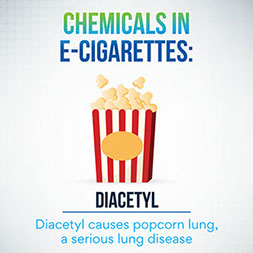
Diacetyl
Over a decade ago, workers in a microwave popcorn factory were sickened by breathing in diacetyl, which is the buttery-flavored chemical found in foods like popcorn, caramel and diary products. While the Food and Drug Administration (FDA) has approved diacetyl as safe to eat, it is not safe to inhale.
When inhaled, diacetyl causes irreversible lung damage known as bronchiolitis obliterans or “popcorn lung.” While the name popcorn lung might not seem dangerous, it is a very serious lung disease that causes coughing, wheezing, and shortness of breath.
Other Dangerous Chemicals
• Carcinogens – chemicals that are known to cause cancer
• Heavy Metals – at least 6 different types of metals such as nickel, lead, tin
• Propylene Glycol – used to make antifreeze, industrial paint, and artificial smoke in fog machines
• Diethylene Glycol – used to make brake fluid and can cause lung disease
• Formaldehyde – used to preserve dead bodies and can damage lung tissue
• Benzene – deadly chemical found in car exhaust
• Cadmium – found in batteries and causes cadmium poisoning or pneumonia-like symptoms
• Acrolein – A herbicide primarily used to kill weeds, can cause irreversible lung damage.
Sources for module 1 include American Lung Association, Centers for Disease Control & Prevention, Behind the Haze, and Truth Initiative.
Say What! EST. 2011
Home | About | Resources | Events | Speak Up | Login
Mailing Address
Texas School Safety Center
ATTN: Say What Program
Texas State University
601 University Drive
San Marcos, TX 78666

Say What! was created and designed by young people from across Texas and connects students interested in eliminating tobacco from their schools and communities. The Say What! movement is funded by the Texas Department of State Health Services through a contract with the
Texas School Safety Center at Texas State University.
